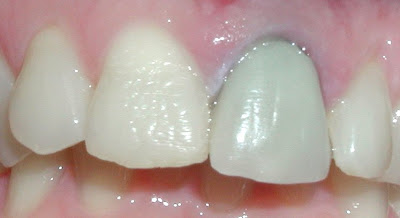In this case the patient was insistent on metal free as they had been researching online (sometime the internet is not helpful!) - and as you can see the root treatment shows through and makes the whole crown look grey - I'm sure it looked great on the model, but in the mouth... not so great, so how do we get around this problem?
As we have discussed in previous blogs, covering a dark tooth with a root treatment and metal free crown is very difficult, so in this case we opted for a totally opaque core.
There aren't many opaque metal free substructures around, so we used Vita Inceram Zirconia - this is a material developed by Vita many years ago before the 'true' zirconia ceramics came out. Vita Inceram Zirconia is a combination of alumina and zirconia which results in high strength and an almost opaque core.
We rarely use this material now as we're not often asked to make an opaque metal free crown (usually a porcelain fused to metal crown is used), however you need to ensure that any laboratory you do decide to use has a detailed knowledge of materials available in order that they can advice as to the best restoration for any case.
Here's the result, still a little greynes showing through, but overall a much improved result.
What experiences do you have of trying to mask dark underlying teeth with metal free? What worked? And what didn't?






